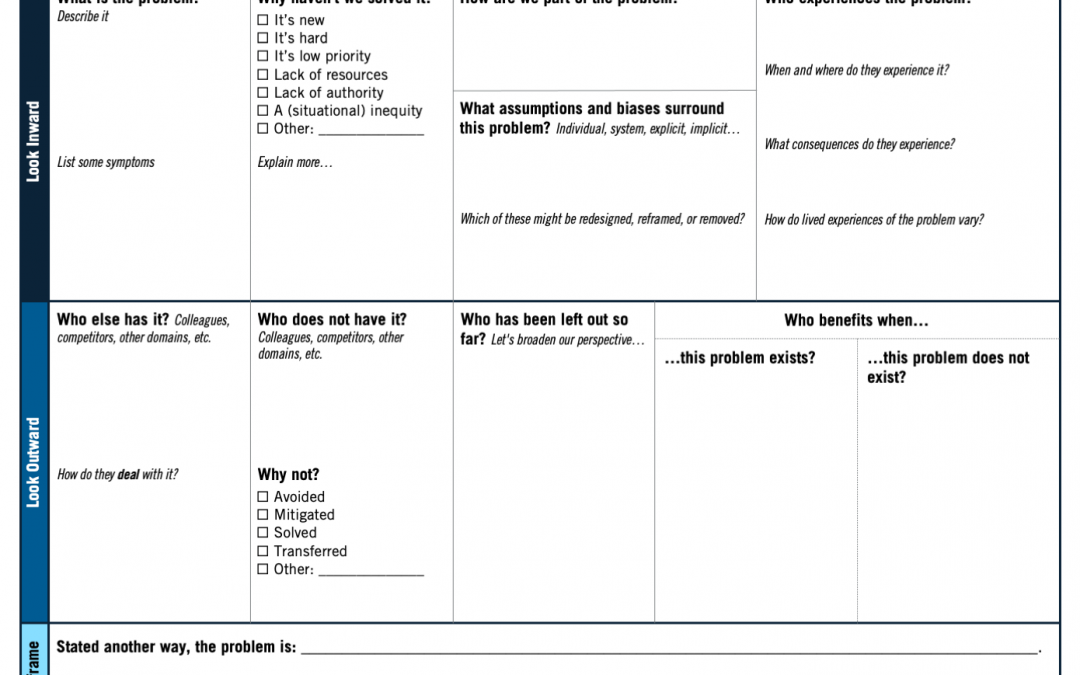Problem Framing

Explore a problem space and formulate a robust problem statement to ensure you’re solving the right problem.
- Time: 45+minutes
- Group Size: 2+ people
- Level: Intermediate

Explore a problem space and formulate a robust problem statement to ensure you’re solving the right problem.


One of the things we love about the ITK tools is how adaptable they are. Each one is lovingly crafted to be easy to use across a wide range of situations… but they are also designed to be modified to meet the unique needs and situations of individual users. We sincerely love it when people take these tools and change them. And we love it even MORE when they share their new creations with us!
A group we’re working with recently did exactly that with one of our favorite tools the Problem Framing Canvas. The result was a Simplified Problem Framing Canvas that we just had to share with the rest of you.
It has all the magic and impact of the original, but in a more focused and tighter structure. I just might like it better than our original one (and that’s really saying something).
SCENARIO: It’s Friday morning. You’re an analyst and just received an urgent request for an analysis due Monday. You are 99% sure a colleague has done this same analysis before, but you have no idea where it was stored. Your options are 1) spend all weekend searching for that old analysis and updating it, or 2) start from scratch and finish a new version by the end of today. Which option do you choose? Is it more efficient to reinvent the wheel? Or to spend the time looking for something which may not be found – or may not even exist?
It often feels like we are stuck choosing the lesser of two evils when faced with a decision like this. Option 1 is risky – what if you don’t end up finding what you need, and you wasted all that time searching? Option 2 can be frustrating – you are pretty sure someone else has done the work already, but you simply don’t have time to figure out how to leverage it.
Team Toolkit recently delivered a workshop to help a group of intelligence analyst to explore solutions to that scenario. We began with a tool called the “Problem Framing Canvas”, which aims to help build a consensus about a problem statement and make sure the team is solving the right problem to begin with. After some discussion, the group agreed that “analysis takes too long” was a pretty good description of the problem. It’s short, clear, and does not dictate a specific solution.
It can be tempting to skip the “defining the problem” phase and move right into “solving the problem,” but building a consensus about the problem is always a worthwhile exercise. The Problem Framing Canvas helped the group identify other groups who also experience this problem (spoiler: MANY other teams) and who has figured out how to solve this problem (not many have – it’s a hard problem!).
After framing the problem, we moved to a second tool, Journey Mapping. A Journey Map is a visual tool that focuses on a user’s experience. It identifies phases, steps, actions, opportunities, and pain points in the analysis process, starting with the request for a product and ending with delivering the product. The process of developing such a map is often just as valuable for the team as the product itself.
Because the participants were geographically dispersed across three different locations, we paused our Skype call to allow each location to sketch out the journey of a typical analyst on the whiteboard, including steps that are typically challenging to accomplish. We then regrouped to share ideas and consolidate everyone’s work into one giant journey map.
The Journey Map highlighted points within the process that contribute to the problem and make analysis take so long. It also helped the team identify opportunities to introduce new processes, practices, and technologies that could speed things up. Participants left the workshop with a visual map of their process and a consolidated list of requirements for a new platform solution they could build, to help analysis go faster.
Hat Tip to Andrea & Allison for co-authoring this story
Last week. Rachel’s blog post looked at the importance of asking Why. This week we’ll take a closer look at the Problem Framing Canvas she mentioned. It’s designed to be used with a team to establish a clear consensus about what problem you’re trying to solve.
When I’m leading one of these sessions, I like to give everyone a copy of the canvas on 11×17 paper, so there’s plenty of room to write. I start by setting a timer for 4 minutes and inviting everyone to spend a little quiet writing time, mostly focused on the first box on the upper left of the canvas (the “What’s the problem?” box).
Then we use the questions on the canvas to guide the discussion (usually 60-90 minutes) and explore different facets of the problem.
In the last 10-15 minutes, we focus on the big box at the bottom (“No, really, what’s the actual problem?”) to document the team’s shared understanding of the problem. The transformation from our initial problem statement to the final problem statement is usually quite striking.
Get your copy of the Problem Framing Canvas (and instructions on how to use it) on the Problem Framing page.